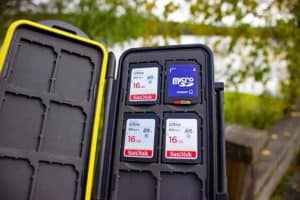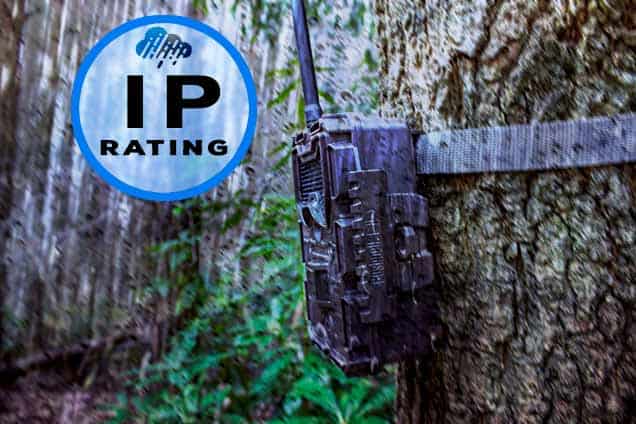

Editor & Article Writer for Outdoor Wilds
Share via:
Are Trail Cameras Waterproof?
Trail cameras are expected to stand up to the most harsh of environmental conditions while functioning the whole time, detecting movement and recording images onto an SD card without any issue. But, are trail cameras waterproof?
In this article I answer this often asked question by taking a brief look at IP ratings and sharing by thoughts on the subject of “waterproof trail cameras”
Definition of Waterproof
If you look up the actual meaning of the word “waterproof” it says, watertight, water-repellent, water resistant and weatherproof. So in other words, the term is open to interpretation.
I would say when most people ask this question they really want to know if their trail camera will stand up to heavy rain and in some cases full immersion under water.
Trail Camera IP Rating
If you look at the specification for most trail cameras and for that matter a lot of other consumer electronics you’ll see an IP rating listed.
IP stands for “Ingress Protection”. The rating has 2 numbers that follow, i.e IP66. The first number denotes the physical size of objects the camera is protected from. A number 6 means total protection from dust.
The second number tells you the water protection. The number 5 would indicate the camera is protected against low pressure water jets, or in a real world environment, the heaviest of rain.
You’ll find most trail cameras fall in between the IP56 and IP66 ratings. Take a look at the table extract below for IP ratings to further get an idea on Ingress Rating and how it relates to trail cameras.
With a clear understanding of the IP Rating you can see that trail cameras are designed to withstand most rain and dust environments. But will a trail camera withstand full water immersion?
Going back to the IP Rating. A trail camera would have to be IP67 rated at least to be able to survive underwater. The number 7 means an electrical device is tested to withstand water ingress up to a depth of 1 metre underwater for up to 30 minutes.
As far as I’m aware, there are no trail cameras currently that are rated IP67. So in theory a trail camera will suffer some water ingress if it becomes submerged.
Trail cameras underwater
Of course there are exceptions. If you take a look at the video below. Several Browning trail cams survived for a week or so underwater when the site became flooded after heavy rain.
The cameras did have to be stored in a dry, warm cupboard and left for an extended period for them to dry out.
If your camera does become saturated inside with water, always remove the batteries. Any power will short circuit the boards and fry them.
Are SD Cards Waterproof?
Are SD cards waterproof? The short answer is yes! in most cases.
If you take a look at the Sandisk [1] website, they have a page detailing environmental tolerance for their SD cards. See the link above.
In essence, Sandisk say that their SD cards are tested to withstand submersion in salt water up to 72 hours with an IP rating of IPX7. Good news if your trail cameras does take a swim in the swamp. At least you’ll be able to retrieve the pictures off the card at the least
Lesser makes of SD card are not so rugged. A quick search on YouTube will bring up a number of tests on different SD card brands and how they stand up to water ingress.
It’s always worth keeping spare SD cards inside a waterproof SD case, just as a precaution.
Summary
Technically, trail cameras are not strictly waterproof as the IP Ratings show. They are designed to withstand rainfall and dust environments and in almost all cases work very well under these conditions.
It’s arguable whether a trail camera will survive underwater. However, remember any water damage to a trail camera may not be covered under the warranty.
if you’d like to know more about general trail camera maintenance then my article covers all the essential basics for prolonging the life of your trail cam.
Condensation build up on a trail camera lens can be the cause of poor quality pictures taken at dawn as the dew rises off the ground. Take a look at my article on how to fix condensation problems with trail cameras.
Trail Camera Posts
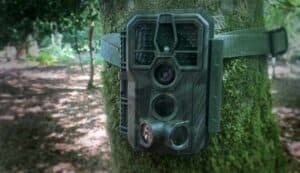
GardePro E5 Trail Camera Review
In this Gardepro E5 trail camera review I share my experiences with the trail cam
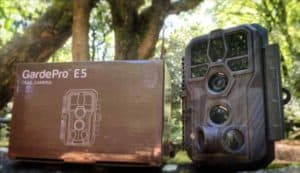
GardePro E5 Trail Camera Unboxing
Today we’re going to take a look at a Gardepro E5 trail camera unboxing
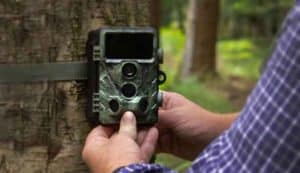
Best Low Glow Trail Camera (Covert Scouting Trail Cameras)
One of the most practical features of any trail camera is the ability to illuminate pictures taken at night without the camera being spotted by animals.
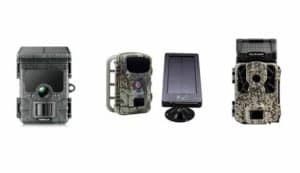
Trail Camera With Solar Panel Comparison (Guide)
If you plan on setting up a trail camera for extended periods without checking on it, a trail camera with a solar panel is well worth considering.

WiFi Trail Cameras Compared (Buying Guide 2023)
A feature that is becoming more popular with trail camera users is WiFi. Here I take a look at 3 WiFi trail cameras in the comparison guide.
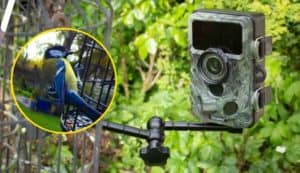
Bird Feeder Trail Camera Set Up (Gear To Use & Tips Guide)
In this guide I want to share with you my current favourite bird feeder trail camera set up which I’m having great success with capturing beautiful video images

